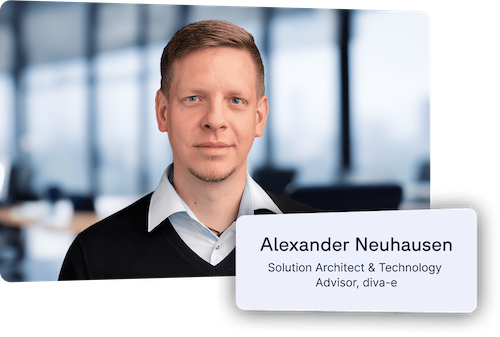Interview with Alexander Neuhausen, Solution Architect and Technology Advisor at diva-e Conclusion
Alexander Neuhausen has been working as a Solution Architect and Technology Advisor at diva-e Conclusion since 2013. With over 25 years of industry experience, his focus is on Technical Due Diligence as well as the development of sustainable architectures and blueprints for digital business. His emphasis is on individual consulting and the creation of measurable value – far beyond established standards or the mere comparison of feature lists.
In this article, Alexander shares his expert knowledge from numerous projects – from the initial questions to success factors and trends in tech consulting.

Part 1: Positioning
What typical questions or challenges do clients bring to us?
“Clients usually approach us with three central challenges:
First, they struggle to identify the right solution for their specific business requirements from the multitude of available technologies.
Second, they often lack the expertise to realistically assess complex integration scenarios and long-term impacts on their IT landscape.
Third, they face internal conflicts of interest between different departments that have varying priorities and requirements.“
In which situations do companies most often turn to us for technology selection?
"Companies seek external support mainly in four situations:
During strategic digitalization initiatives that affect the entire business model.
When legacy systems need to be renewed and major investments are at stake.
In complex integration projects involving multiple business units.
When internal resources or expertise for an objective evaluation are lacking."
What typical mistakes or challenges do you see in companies that approach tech evaluation without external support?
“The most common mistake is a technology-driven rather than business-driven approach. Companies often fall in love with features and marketing claims without evaluating the actual business value.
They also regularly underestimate integration costs and change management efforts. Another critical issue is incomplete stakeholder involvement, which leads to important requirements being overlooked.
Many companies also think in outdated software categories from the 2000s and try to innovate with standard solutions instead of considering modern, composable architectures.“
Part 2: Requirements Analysis and Goal Definition
How do we help clients identify their actual technology needs?
"We always start with a comprehensive business strategy analysis before talking about technology. Through digital due diligence we gain an understanding of the current IT landscape and identify weaknesses.
We then conduct structured stakeholder interviews and workshops to capture both explicit and implicit requirements. We use proven frameworks for requirements analysis and create user journey maps to understand the actual needs from the user’s perspective."
Which methods do we use to structure requirements clearly?
"We apply a multi-step approach with different workshop formats: business strategy workshops to clarify business objectives, requirements engineering sessions for detailed requirement gathering, and architecture design thinking workshops for technical design. In addition, we use proven frameworks such as TOGAF for enterprise architecture and agile methods for iterative refinement of requirements."
How do we distinguish between “must-have” requirements and “nice-to-have” features?
"We evaluate requirements based on their direct impact on defined business objectives and KPIs:
Must-have requirements are those without which the business objective cannot be achieved or critical compliance requirements would be violated.
Nice-to-have features improve the solution but are not business-critical.
This prioritization is carried out together with the business units, taking ROI calculations and strategic objectives into account."
Part 3: Evaluation and Decision-Making Processes
By which criteria do we help clients evaluate technologies?
"We use a structured evaluation framework with weighted criteria:
Business value and strategic fit have top priority, followed by functional coverage of core processes. Technical criteria such as scalability, IT security, and integrability are evaluated alongside total cost of ownership and vendor stability. Change management factors such as user-friendliness and training requirements are also particularly important.
Depending on the need, complexity, and level of detail, this can involve hundreds of criteria, weighted and prioritized according to their relevance and impact, to ensure the most objective evaluation possible.
Another important aspect, often overlooked, is the role of data strategy and governance in technology decisions. Modern solutions are only as good as the data quality they process. That is why we integrate master data management and data governance into our evaluations right from the start."
How do we ensure transparency in the decision-making process for all stakeholders in the client company?
"We ensure transparency through a clear evaluation matrix with comprehensible criteria and weightings, defined jointly with all stakeholders – every evaluation is documented and justified.
Joint meetings provide continuous communication. In addition, all stakeholders receive access to the evaluation results in an understandable format. Important decisions are therefore always made in consensus rounds, not by individuals."
What role do proof-of-concepts play in our consulting?
"Proof-of-concepts are essential but used strategically. We conduct them only after the initial pre-selection to practically validate the most promising solutions.
Especially for critical functional, integration, or performance requirements, PoCs are indispensable. We structure them as “lab days” with relevant use cases, defined test scenarios, and measurable success criteria instead of sales feature presentations – always with the goal of providing objective decision-making bases."
Part 4: Challenges in Tech Consulting
What typical pitfalls do we see with clients in tech evaluation projects?
"The most common pitfalls are unclear product vision and strategy, as well as the indispensable target operating model. That is why this is always the starting point of architecture consulting or technology selection. Many clients also underestimate the complexity of data migrations and change management processes. Another critical issue is unrealistic time expectations and budget assumptions, especially when legacy systems are involved."
How do we deal with unrealistic expectations or resistance within client organizations?
"When faced with unrealistic expectations, we rely on fact-based clarification with concrete examples and reference projects. We document risks transparently and show alternative solutions. In the case of resistance, we conduct targeted stakeholder discussions to understand the causes and address individual concerns.
Change management begins with the definition of strategy and product vision, not only at the implementation stage."
What role does change management play in our client projects?
"Change management is an integral part of our approach, not just a downstream topic – often it is also the decisive factor in technology selection.
Already during technology evaluation we consider change impact analyses and adoption factors. In parallel with the technical solution, we develop the target operating model and define new roles and processes. Success measurement always includes adoption KPIs, not just technical metrics."
Part 5: Success Factors
What are the most important factors for a technology decision to be successful in the long run?
"The most critical success factor is consistent alignment with business objectives rather than technical features. This includes a well-thought-out change management strategy from the outset, since the best technology is worthless if it is not adopted. A future-proof overall architecture that enables flexibility and scalability is also essential. Finally, clear governance structures and continuous performance measurement after implementation are needed."
Part 6: Trends and Forecasts
What trends do we currently see in tech consulting and tech evaluation?
"There is a clear shift from monolithic solutions and architectures to service-oriented and composable architectures, as well as stronger IT/OT integration.
Enterprise architects are evolving into strategic business advisors working closely with management and business units. The use of AI, sustainability, and ESG criteria are becoming increasingly important evaluation factors. We are also seeing stronger integration of business and IT strategy consulting.
In addition, we observe that compliance and regulatory requirements are increasingly driving technical decisions, especially in regulated industries. This requires close collaboration between legal, compliance, and IT teams already in the evaluation phase."
Will new methods change tech consulting in the coming years?
"AI-supported analyses are already helping to evaluate large vendor landscapes and automate parts of the initial market analysis. Nevertheless, strategic consulting, stakeholder management, and change support remain core human competencies. The art lies in combining technical efficiency with practical, human expertise."


